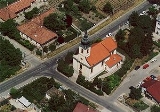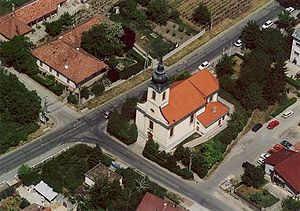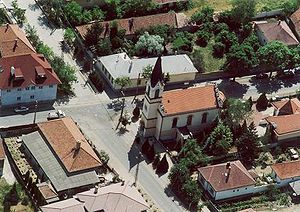
Csömör
Encyclopedia
Csömör (ˈtʃømør) is a village in Hungary
, in Pest county, Budapest metropolitan area
in the Gödöllő subregion (kistérség). It is west of Kistarcsa
, north of the 16th district of Budapest, on the western part of the Gödöllő
hills, in the turning of the Csömör stream. It has a population of 8,433 (2007).


(3200–3000 BC) in the area of the Urasági-tag, the Bab-földek (bone fields) and the Rét-pótlék.
Ceramic pieces were found from the bronze age
(1900–1800 BC) on the area of the Urasági-tag ˈuɾɒʃaːɡitɒɡ and the Szeder-völgyi-dűlő [ˈsedeɾvœlɟi ˈdyːløː]. On the 64 Erzsébet Street [ˈɛɾʒeːbet] were found troves from the vatyai culture [ˈvɒcɒʲi] (1700–1400 BC).
A Celtic cemetery was dug out behind the strand, which is from the iron age
(380–300 BC). Between the troves there are bracelets, fibulas, chiffons, a scabbard with sword, and chain.
During the third and the fourth century there was a Sarmatian
village on the area of Csömör, both sides of the stream. During the explorations a Roman
bowl (from the third century) and pottery were found.
Pieces of bowl were found on the area of the Réti-dűlős [ˈɾeːti ˈdyːløː] (singular: Réti-dűlő) and Rétpótlék [ˈɾeːtpoːtleːk] from the Avar age
.
Ceramic pieces were found on the area of the Káposztáss [ˈkaːpostaːʃ] (singular: Káposztás) and Réti-dűlős, that were made during the tenth and the eleventh century.
Hungary
Hungary , officially the Republic of Hungary , is a landlocked country in Central Europe. It is situated in the Carpathian Basin and is bordered by Slovakia to the north, Ukraine and Romania to the east, Serbia and Croatia to the south, Slovenia to the southwest and Austria to the west. The...
, in Pest county, Budapest metropolitan area
Budapest metropolitan area
The Budapest Metropolitan Area is a metropolitan area in Central Hungary. It consists of Budapest capital and the surrounding suburbs. It has a population of 2.525 million...
in the Gödöllő subregion (kistérség). It is west of Kistarcsa
Kistarcsa
Kistarcsa is a town in Pest county, Budapest metropolitan area, Hungary.Site of the Nazi camp for political prisoners during the Second World War.- External links :*...
, north of the 16th district of Budapest, on the western part of the Gödöllő
Gödöllo
Gödöllő is a town situated in Pest county, Budapest metropolitan area, Hungary, about northeast from the outskirts of Budapest. Its population is about 31,000 according to the 2001 census. It can be easily reached from Budapest with the suburban railway . Gödöllő is home to the Szent István...
hills, in the turning of the Csömör stream. It has a population of 8,433 (2007).


History
Ceramic pieces were found from the new stone ageNeolithic
The Neolithic Age, Era, or Period, or New Stone Age, was a period in the development of human technology, beginning about 9500 BC in some parts of the Middle East, and later in other parts of the world. It is traditionally considered as the last part of the Stone Age...
(3200–3000 BC) in the area of the Urasági-tag, the Bab-földek (bone fields) and the Rét-pótlék.
Ceramic pieces were found from the bronze age
Bronze Age
The Bronze Age is a period characterized by the use of copper and its alloy bronze as the chief hard materials in the manufacture of some implements and weapons. Chronologically, it stands between the Stone Age and Iron Age...
(1900–1800 BC) on the area of the Urasági-tag ˈuɾɒʃaːɡitɒɡ and the Szeder-völgyi-dűlő [ˈsedeɾvœlɟi ˈdyːløː]. On the 64 Erzsébet Street [ˈɛɾʒeːbet] were found troves from the vatyai culture [ˈvɒcɒʲi] (1700–1400 BC).
A Celtic cemetery was dug out behind the strand, which is from the iron age
Iron Age
The Iron Age is the archaeological period generally occurring after the Bronze Age, marked by the prevalent use of iron. The early period of the age is characterized by the widespread use of iron or steel. The adoption of such material coincided with other changes in society, including differing...
(380–300 BC). Between the troves there are bracelets, fibulas, chiffons, a scabbard with sword, and chain.
During the third and the fourth century there was a Sarmatian
Sarmatians
The Iron Age Sarmatians were an Iranian people in Classical Antiquity, flourishing from about the 5th century BC to the 4th century AD....
village on the area of Csömör, both sides of the stream. During the explorations a Roman
Roman Empire
The Roman Empire was the post-Republican period of the ancient Roman civilization, characterised by an autocratic form of government and large territorial holdings in Europe and around the Mediterranean....
bowl (from the third century) and pottery were found.
Pieces of bowl were found on the area of the Réti-dűlős [ˈɾeːti ˈdyːløː] (singular: Réti-dűlő) and Rétpótlék [ˈɾeːtpoːtleːk] from the Avar age
Eurasian Avars
The Eurasian Avars or Ancient Avars were a highly organized nomadic confederacy of mixed origins. They were ruled by a khagan, who was surrounded by a tight-knit entourage of nomad warriors, an organization characteristic of Turko-Mongol groups...
.
Ceramic pieces were found on the area of the Káposztáss [ˈkaːpostaːʃ] (singular: Káposztás) and Réti-dűlős, that were made during the tenth and the eleventh century.

